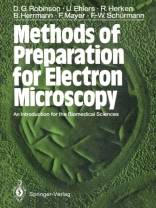In 1939, when the electron optics laboratory of Siemens & Halske Inc. began to manufacture the first electron microscopes, the biological and medical profes- sions had an unexpected instrument at their disposal which exceeded the reso- lution of the light microscope by more than a hundredfold. The immediate and broad application of this new tool was complicated by the overwhelming prob- lems inherent in specimen preparation for the investigation of cellular struc- tures. The microtechniques applied in light microscopy were no longer appli- cable, since even the thinnest paraffin layers could not be penetrated by electrons. Many competent biological and medical research workers expressed their anxiety that objects in high vacuum would be modified due to complete dehydration and the absorbed electron energy would eventually cause degrada- tion to rudimentary carbon backbones. It also seemed questionable as to whether it would be possible to prepare thin sections of approximately 0. 5 11m from heterogeneous biological specimens. Thus one was suddenly in posses- sion of a completely unique instrument which, when compared with the light microscope, allowed a 10-100-fold higher resolution, yet a suitable preparation methodology was lacking. This sceptical attitude towards the application of electron microscopy in bi- ology and medicine was supported simultaneously by the general opinion of colloid chemists, who postulated that in the submicroscopic region of living structures no stable building blocks existed which could be revealed with this apparatus.
Ulrich Ehlers & Rainer Herken
Methods of Preparation for Electron Microscopy [PDF ebook]
An Introduction for the Biomedical Sciences
Methods of Preparation for Electron Microscopy [PDF ebook]
An Introduction for the Biomedical Sciences
Compre este e-book e ganhe mais 1 GRÁTIS!
Língua Inglês ● Formato PDF ● ISBN 9783642488481 ● Tradutor David G. Robinson ● Editora Springer Berlin Heidelberg ● Publicado 2012 ● Carregável 3 vezes ● Moeda EUR ● ID 6379076 ● Proteção contra cópia Adobe DRM
Requer um leitor de ebook capaz de DRM












